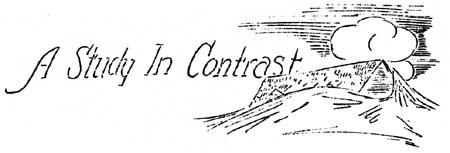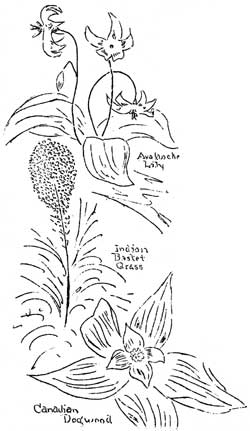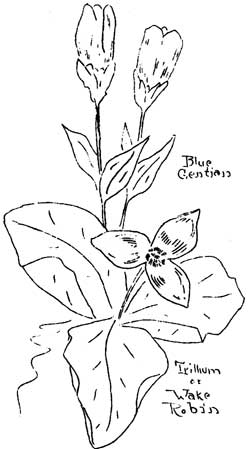A STUDY IN CONTRAST

 If you were to visit Paradise Valley at this time of the year and could
see the entire region held fast in winter's icy grip -- with all the
buildings snowed under or with but a portion of their roofs exposed --
you would wonder if any kind of flower could ever bloom here.
And yet if you saw the same place at the height of the summer season
when the hills everywhere are carpeted with a mass of varied flowers
whose brilliance embraces every shade in the rainbow, we could not blame
you a particle if you scoffed at the stories that you would hear
relative to the enormous amount of snow which is customary here. These
high parks about "The Mountain" are certainly studies in contrast!
If you were to visit Paradise Valley at this time of the year and could
see the entire region held fast in winter's icy grip -- with all the
buildings snowed under or with but a portion of their roofs exposed --
you would wonder if any kind of flower could ever bloom here.
And yet if you saw the same place at the height of the summer season
when the hills everywhere are carpeted with a mass of varied flowers
whose brilliance embraces every shade in the rainbow, we could not blame
you a particle if you scoffed at the stories that you would hear
relative to the enormous amount of snow which is customary here. These
high parks about "The Mountain" are certainly studies in contrast!
With the melting of the snow comes the Avalanche Lily or Dogtooth
Violet whose legions advance on the heels of the receeding snowbanks --
oftentimes pushing their way through the snow itself. It's beauty is
rivaled in the high parks at that early season by the Western Anemone
whose large buttercup-like flowers fall apart in a short time to give
way to the development of unique seed pods, that resemble an old
fashioned feather duster, in the fall. In the dense timber of the lower
slopes we find the fragrant Twinflower, a member of the Honeysuckle
family, the Canadian Dogwood and the Trillium which is the earliest of
our flowers in the Park and which is, even now, in bloom here and
there.
 There are approximately 750 species of flowering plants native to this
Park, embracing all manner of habitat. We find the Oregon Grape, Salal
and Pacnystima among the vegetation of the moist, shaded forest floor at
the lower elevations; Skunk Cabbage, Shooting Star and the Red and
Yellow Mimulus grows in marshy or very moist places while the barren
cliffs are brightened by the Pentstemon which seems to find ample
nourishment in some crevice. And of course the Indian Paint Brush,
Lupine and various members of the Aster family brighten the meadows.
There is heather too -- three species, the red, the white and the yellow
being most common. But the number of species is not the remarkable
thing about our flower fields -- it is the spontaneity of bloom that
arouses interest. The variety of flowers that would ordinarily occupy a
blooming period of several months literally burst into flower under the
influence of warm July sunshine and the ample moisture of receeding
snowbanks. And so the variety of color and species as well as their
great number is concentrated in the rather short period between the
disappearance of the snow in mid summer to the return of King Boreas to
the region in the early fall.
There are approximately 750 species of flowering plants native to this
Park, embracing all manner of habitat. We find the Oregon Grape, Salal
and Pacnystima among the vegetation of the moist, shaded forest floor at
the lower elevations; Skunk Cabbage, Shooting Star and the Red and
Yellow Mimulus grows in marshy or very moist places while the barren
cliffs are brightened by the Pentstemon which seems to find ample
nourishment in some crevice. And of course the Indian Paint Brush,
Lupine and various members of the Aster family brighten the meadows.
There is heather too -- three species, the red, the white and the yellow
being most common. But the number of species is not the remarkable
thing about our flower fields -- it is the spontaneity of bloom that
arouses interest. The variety of flowers that would ordinarily occupy a
blooming period of several months literally burst into flower under the
influence of warm July sunshine and the ample moisture of receeding
snowbanks. And so the variety of color and species as well as their
great number is concentrated in the rather short period between the
disappearance of the snow in mid summer to the return of King Boreas to
the region in the early fall.
When are the flower fields at their best? Ordinarily the last week
or ten days of July and the first week or ten days in August.
NOTE: all readers of Nature News Notes who wish to continue receiving
this bulletin during the coming year should please fill out the blank
below. These from whom a notice is not received by June 1, 1929 will be
dropped from the mailing list.
Name: _________________________ Address:_______________________
_______________________________________________________________
Nature News Notes is mailed free, anywhere in the United States to
anyone interested in the Natural History of this Park. The Educational
Department encourages suggestions, criticism or inquiries regarding this
bulletin and the region which it attempts to describe. Once each year a
check is made of the mailing list in order that these efforts shall go
to those who are most interested in the outdoors and Mt. Rainier Nat'l
Park. If you wish to continue fill out the blank; if not, no
reply is necessary.

